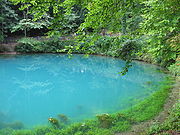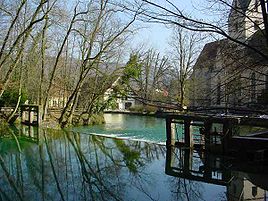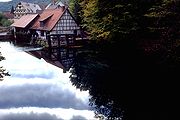
Blautopf
Encyclopedia

Spring (hydrosphere)
A spring—also known as a rising or resurgence—is a component of the hydrosphere. Specifically, it is any natural situation where water flows to the surface of the earth from underground...
that serves as the source of the river Blau
Blau (Danube)
The Blau is a 15 km long river in Baden-Württemberg, southern Germany, and a left tributary of the Danube. The source of the Blau is the karst spring of Blautopf, in the town Blaubeuren, in the Swabian Jura. It flows east through Blaustein to the city of Ulm, where it empties into the...
in the karst
Karst topography
Karst topography is a geologic formation shaped by the dissolution of a layer or layers of soluble bedrock, usually carbonate rock such as limestone or dolomite, but has also been documented for weathering resistant rocks like quartzite given the right conditions.Due to subterranean drainage, there...
landscape on the Swabian Alb
Swabian Alb
The Swabian Alps or Swabian Jura is a low mountain range in Baden-Württemberg, Germany, extending 220 km from southwest to northeast and 40 to 70 km in width. It is named after the region of Swabia....
's southern edge, in Southern Germany
Germany
Germany , officially the Federal Republic of Germany , is a federal parliamentary republic in Europe. The country consists of 16 states while the capital and largest city is Berlin. Germany covers an area of 357,021 km2 and has a largely temperate seasonal climate...
. It is located in the city of Blaubeuren
Blaubeuren
Blaubeuren is a town in the district of Alb-Donau near Ulm in Baden-Württemberg, Germany.It has 11.963 inhabitants as of December 2007.-Coat of arms:...
, approximately 16 km (9.9 mi) west of Ulm
Ulm
Ulm is a city in the federal German state of Baden-Württemberg, situated on the River Danube. The city, whose population is estimated at 120,000 , forms an urban district of its own and is the administrative seat of the Alb-Donau district. Ulm, founded around 850, is rich in history and...
. It forms the drain for the Blau cave
Cave
A cave or cavern is a natural underground space large enough for a human to enter. The term applies to natural cavities some part of which is in total darkness. The word cave also includes smaller spaces like rock shelters, sea caves, and grottos.Speleology is the science of exploration and study...
system and feeds the river Blau, which after 14.5 km (9 mi), flows into the river Danube
Danube
The Danube is a river in the Central Europe and the Europe's second longest river after the Volga. It is classified as an international waterway....
in the city of Ulm. Because of its high water pressure, the spring has developed a funnel-like shape, which at its deepest point has a depth of 21 metres (69 ft). The water's blue color is the result of chemical properties of limestone
Limestone
Limestone is a sedimentary rock composed largely of the minerals calcite and aragonite, which are different crystal forms of calcium carbonate . Many limestones are composed from skeletal fragments of marine organisms such as coral or foraminifera....
densely distributed in the water.
Legends

Legend
A legend is a narrative of human actions that are perceived both by teller and listeners to take place within human history and to possess certain qualities that give the tale verisimilitude...
s and folk tales refer to the Blautopf. Its characteristic colour was explained by the account that every day someone would pour a vat of ink into the Blautopf. Another myth stated that every time someone tried to measure the Blautopf's depth with a leaden sounding line
Sounding line
A sounding line or lead line is a length of thin rope with a plummet, generally of lead, at its end. Regardless of the actual composition of the plummet, it is still called a "lead."...
, a water nix
Nix
The Neck/Nixie are shapeshifting water spirits who usually appear in human form. The spirit has appeared in the myths and legends of all Germanic peoples in Europe....
stole the sounding line. Therefore, it was not possible to determine the depth of the Blautopf. Because of this tale, there is a rock called Klötzle Blei ("little block of lead" in the local dialect) in the vicinity of the Blautopf. A well-known tongue-twister
Tongue-twister
A tongue-twister is a phrase that is designed to be difficult to articulate properly, and can be used as a type of spoken word game. Some tongue-twisters produce results which are humorous when they are mispronounced, while others simply rely on the confusion and mistakes of the speaker for their...
in the Swabian
Swabian German
Swabian is one of the Alemannic dialects of High German. It is spoken in Swabia, a region which covers much of Germany's southwestern state Baden-Württemberg, including its capital Stuttgart, the rural area known as the Swabian Alb, and Bavaria...
dialect told to local children, refers to this rock:
- Glei bei Blaubeira leit a Kletzle Blei -
- ´s leit a Kletzle Blei glei bei Blaubeira
Standard High German:
- Gleich bei Blaubeuren liegt ein Klötzchen Blei -
- Es liegt ein Klötzchen Blei gleich bei Blaubeuren
English Translation:
- Near Blaubeuren, there lies a block of lead -
- There lies a block of lead near Blaubeuren
The novelist and poet Eduard Mörike
Eduard Mörike
Eduard Friedrich Mörike was a German Romantic poet.-Biography:Mörike was born in Ludwigsburg. His father was Karl Friedrich Mörike , a district medical councilor; his mother was Charlotte Bayer...
incorporated this folklore
Folklore
Folklore consists of legends, music, oral history, proverbs, jokes, popular beliefs, fairy tales and customs that are the traditions of a culture, subculture, or group. It is also the set of practices through which those expressive genres are shared. The study of folklore is sometimes called...
and other tales into the romantic
Romanticism
Romanticism was an artistic, literary and intellectual movement that originated in the second half of the 18th century in Europe, and gained strength in reaction to the Industrial Revolution...
novella
Novella
A novella is a written, fictional, prose narrative usually longer than a novelette but shorter than a novel. The Science Fiction and Fantasy Writers of America Nebula Awards for science fiction define the novella as having a word count between 17,500 and 40,000...
Das Stuttgarter Hutzelmännlein. They were woven into the background story of a journeyman travelling from Stuttgart
Stuttgart
Stuttgart is the capital of the state of Baden-Württemberg in southern Germany. The sixth-largest city in Germany, Stuttgart has a population of 600,038 while the metropolitan area has a population of 5.3 million ....
to Blaubeuren. In particular, the story of the Schöne Lau, a mermaid
Mermaid
A mermaid is a mythological aquatic creature with a female human head, arms, and torso and the tail of a fish. A male version of a mermaid is known as a "merman" and in general both males and females are known as "merfolk"...
, and her husband, a male water-nix from the Black Sea
Black Sea
The Black Sea is bounded by Europe, Anatolia and the Caucasus and is ultimately connected to the Atlantic Ocean via the Mediterranean and the Aegean seas and various straits. The Bosphorus strait connects it to the Sea of Marmara, and the strait of the Dardanelles connects that sea to the Aegean...
, is told in great detail. Because the Schöne Lau could not laugh, the nix punished her by confining her to the Blautopf, and only allowing her to have still-born children. He would only allow her to return and give birth to a living child once she had laughed five times. In the end, the landlady of the inn Nonnenhof came to her aid. (The complete German
German language
German is a West Germanic language, related to and classified alongside English and Dutch. With an estimated 90 – 98 million native speakers, German is one of the world's major languages and is the most widely-spoken first language in the European Union....
text is available at Eduard Mörike: Die Schöne Lau.)
Geology

Karst topography
Karst topography is a geologic formation shaped by the dissolution of a layer or layers of soluble bedrock, usually carbonate rock such as limestone or dolomite, but has also been documented for weathering resistant rocks like quartzite given the right conditions.Due to subterranean drainage, there...
environment. One characteristic of a Karst environment is that water, which drains quickly through the limestone in one area, surfaces in another. Karst environments only have subterranean drainage, and there are no bodies of water above ground. Therefore, the size of the Blautopf depends greatly on the level of rainfall, though it never entirely dries out. The Blautopf is the second largest spring in Germany
Germany
Germany , officially the Federal Republic of Germany , is a federal parliamentary republic in Europe. The country consists of 16 states while the capital and largest city is Berlin. Germany covers an area of 357,021 km2 and has a largely temperate seasonal climate...
, after the Aachtopf
Aachtopf
The Aachtopf is Germany's biggest natural spring, producing an average of 8,500 litres per second. Production varies seasonally and in response to the weather, but the spring never runs dry...
.
Over millennia, subterranean water has created a huge system of caves in the area. Prominent examples are the Blauhöhle
Blauhöhle
The Blauhöhle is the largest cave system in the Swabian Alps in southern Germany. The Blauhöhle presumably originated in a time when the Danube still flowed through the Blau valley. Since the shifting of the Danube, several small rivers, the Schmiech, the Ach, and the Blau, have flowed through this...
(Blau-cave), discovered by Jochen Hasenmeyer in 1985, and the Apokalypse (Apocalypse), discovered on 23 September 2006 by Jochen Malmann and Andy Kücha, members of the Arbeitsgemeinschaft Blautopf, a club dedicated to the exploration of the Blautopf's cave system. While the Blauhöhle is completely filled with water for a length of about 1500 metres (approximately 4935 ft), the Apokalypse is dry; because of its dimensions—170 metres long, 50 metres wide, 50 metres high—it is a special feature of the region.
Diving in the Blautopf

Blauhöhle
The Blauhöhle is the largest cave system in the Swabian Alps in southern Germany. The Blauhöhle presumably originated in a time when the Danube still flowed through the Blau valley. Since the shifting of the Danube, several small rivers, the Schmiech, the Ach, and the Blau, have flowed through this...
lies at a depth of about 18 metres (approximately 60 ft). Therefore, access is restricted to experienced and well-trained divers. In the 1980s, city authorities were forced to prohibit diving in the Blautopf after several accidents, including some fatal ones. Permission to dive in the Blautopf has only been granted to a few organizations: among them, the Arbeitsgemeinschaft Blautopf, a group of scientific speleologists
Speleology
Speleology is the scientific study of caves and other karst features, their make-up, structure, physical properties, history, life forms, and the processes by which they form and change over time...
led by Jochen Hasenmayer, and rescue services. The most recent fatal accident occurred in 2003, killing a member of Hasenmayer's team.
Attractions
Near the Blautopf is a hammermillHammermill
A hammermill is a machine whose purpose is to shred or crush aggregate material into smaller pieces. These machines have many sorts of applications in many industries, including:*Ethanol plants...
fed by the water of the spring. A film, which documents the exploration of the cave, is shown at the same location.

